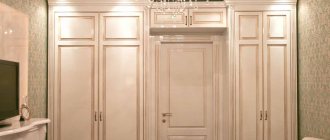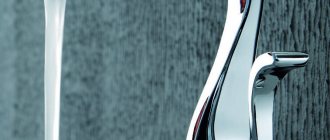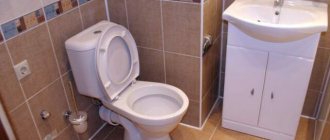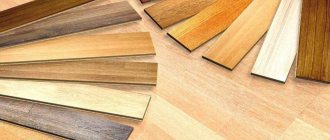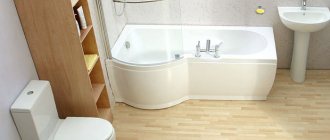Today we will try to figure out the question of how to choose linoleum for your home in terms of quality and reasonable price from the variety of options that building materials stores offer us.
Linoleum still remains one of the most affordable and popular floor coverings, so the topic is relevant.
I hope that this article will help you not to succumb to advertising tricks and, guided not by your own emotions, but by the information received, make the right choice.
If you are bored reading about the types, types and technical characteristics of linoleum, then you can immediately move on to the fifth paragraph of the article. There you can read useful recommendations directly on choosing linoleum.
Description
Commercial linoleum is used as a floor covering in high-traffic areas - essentially, it is a version of an industrial flooring material. May vary depending on how many layers each specific option includes. The most common method of sale is in lengths, the length of which can be chosen by the buyer.
The main component of the coating is PVC, which is highly resistant to wear, due to which its service life is much longer than that of many analogues. And the painted top layer allows the coating to serve without wearing off for a very long period.
Commercial linoleum is best used for high traffic areas
Advantages and disadvantages of marmoleum
Positive aspects of using natural linoleum:
- environmentally friendly coating without substances harmful to humans;
- high resistance to wear during operation;
- absolute antistatic – the coating does not accumulate static electricity;
- very long service life;
- resistance to various chemical factors;
- fire resistance, providing complete protection against fires;
- has bactericidal properties;
- It is very easy to care for this coating;
- It is possible to lay the coating on top of a heated floor system.
There are also disadvantages to this material:
- It is very difficult to carry out high-quality installation, since there are a number of special requirements for the installation process, and non-standard conditions for transportation are also required. It is quite difficult to install it yourself, so it is recommended to seek the help of specialists if the owner wants to get a high-quality floor covering that is not embarrassing to publish in a photo on a social network or present to guests;
- very high price.
Features of linoleum
Today, linoleum is produced by many factories around the world. By the way, in European countries this product is still called natural linoleum, but in Russia it is called marmoleum.
Starting from the mid-20th century, PVC linoleum began to be widely produced in the USSR - this was due to the lack of a sufficient amount of natural ingredients. Despite the fact that this material had practically no similarities with the original, the name still remained the same.
Speaking about linoleum made from synthetic materials, we can distinguish two main varieties - homogeneous (having a structure of a homogeneous nature) and heterogeneous (consisting of several layers).
There are two types of linoleum - homogeneous and heterogeneous
In turn, multilayer linoleum consists of the following components.
- The main layer, which consists of polyvinyl chloride and is a non-woven felt cloth. Some companies, for example, Utex or Tarket, use a duplicate base.
- The front layer - it consists of high-density PVC itself, onto which a decorative pattern is applied in accordance with the design decision. There are also the most popular options such as patterns in the form of natural wood, ceramics or abstract patterns.
- The wear layer is a protective layer made of polyurethane or a complex of synthetic materials that protects linoleum from increased load and allows it to normally withstand exposure to liquids, sunlight and household substances.
Heterogeneous linoleum consists of several layers, the number of which may vary depending on the type of linoleum
Heterogeneous linoleum
Most large manufacturers usually add several more layers of material - so, to seal from the inside, you can add layers that will prevent the material from absorbing water, etc.
So, in total, on the market you can find both linoleum made from natural materials (called marmoleum), as well as synthetic and PVC linoleum (the latter is made in strips or rolls.
There are also types of this coating intended for specific industrial use and difficult operating conditions - in transport, in factory premises, etc.
Types of linoleum for floors depending on structure
Linoleum for flooring can be divided into types according to the following criteria: it has a base or backing, or it does not. The performance qualities of this flooring largely depend on this.
In addition, linoleum is divided into types depending on whether it is single-layer in structure or multi-layer. In this case, it can be either homogeneous or heterogeneous.
Let's look at all these options in more detail.
Linoleum without base
Perhaps the only advantage of this type of linoleum is its low price. Well, one more thing is that it is recommended to use it in particularly damp areas. The rest of his indicators are not so attractive.
It has a thickness of up to 1.6 mm and is characterized by low durability. The average service life of such linoleum is 5-7 years.
In addition, it only needs to be laid on a completely flat floor. Otherwise, all the irregularities and defects will be visible on it.
Currently, the baseless type of linoleum is not very common, so it makes no sense to dwell on it in more detail.
Linoleum with base
This type of linoleum is of higher quality, but its price will certainly be higher than the previous one.
There are two types of bases for such linoleum.
Warm base
Linoleum on a warm or textile basis is perceived by many as warmer, but this cannot be said unequivocally. The fact is that previously such linoleum was made with a base in the form of natural felt or pressed flax, which really have good heat-insulating properties.
But such a substrate also has negative properties - it is not recommended for use in damp rooms, such as the bathroom and kitchen, since the natural material is susceptible to rotting, the formation of fungus and other evil spirits.
For this reason, synthetic fibers began to be added to the base or replaced with a completely natural base.
Therefore, the concept of a warm base becomes somewhat arbitrary.
A positive property of this type of linoleum can be considered its ability to hide roughness and minor floor defects.
It is better to lay such linoleum in one piece without joints to prevent moisture from entering.
The resistance to mechanical stress and stretching of such linoleum is also not very high.
Foam base
Linoleum with a foam base is more versatile in use, as it can be used both in environments with high humidity and with increased mechanical loads.
This is a linoleum structure consisting of five layers.
The first outer layer is protective and is a thin film of transparent high-density polyvinyl chloride. It is this layer that is designed to protect the floor covering from abrasion.
The second layer is responsible for the aesthetic perception of linoleum, that is, for its decorative properties. It is a special paint that is applied to the surface in the form of a specific pattern during the manufacture of linoleum.
The third layer is a face layer of PVC foam on which paint is applied. On the same layer, embossing is performed, imitating parquet or laminate.
The fourth layer is made of fiberglass, which is responsible for the strength properties of linoleum. In general, the production of this floor covering begins with the application of face foam to the fiberglass, and only then the remaining layers. So, in essence, fiberglass is the first layer. But since we started counting from the outer surface, it will be the fourth one.
The fifth layer is a back PVC foam, but only thicker than the front foam. It is this layer that is responsible for the warmth, comfort, and sound insulation of the floor covering.
So we have looked at the main types of linoleum for flooring and can already begin to judge which one is more suitable for the kitchen and which is a risky option.
Homogeneous type of linoleum
The main difference between this type of flooring is that it is homogeneous in its structure and has no layers. That is, a decorative coating with some kind of pattern is not applied to its surface. This linoleum has a uniform color over the entire area. This is a disadvantage if the decorative properties of linoleum are important to you.
But this coating has its significant advantages:
- With homogeneous linoleum, it is impossible to erase a pattern or wipe a stain, since its color is uniform throughout its thickness.
- This linoleum is practically non-flammable due to the dolomite content.
- It has high strength due to the content of quartz sand in its composition.
- Such linoleum can be welded without problems, which eliminates joints between the sheets and the ingress of debris and moisture under them.
- Thanks to the properties listed above, homogeneous linoleum is very durable.
Differences between household and commercial linoleum
At first glance, the differences between these two types of flooring may not be obvious. First of all, however, the price catches your eye - household linoleum is used everywhere and is quite cheap, the intermediate option in the form of semi-commercial linoleum is sold at an average price, and the highest price will have to be paid for dense and reliable commercial linoleum.
Commercial linoleum has a higher price than household
All details about the coating can be seen on the labeling, however, the information from the tags may not always be completely clear to the uninitiated user.
First, pay attention to the visual component, namely, consider the linoleum from the side. A thin protective layer will be visible on the front side - this is what indicates what class the linoleum belongs to. Typically the thickness of this layer will be from 0.1 mm to 1 mm.
Thus, for household linoleum, the protective layer will be the thinnest and most unreliable; it rarely protects against anything other than minor household violations - its thickness will rarely exceed 0.2 mm.
If we are talking about semi-commercial linoleum, then it will have a denser and thicker protective layer, which will be about 0.4 mm.
The thickness of the protective layer of commercial linoleum is quite large - about 1 mm
And for commercial linoleum, the thickness of this layer will reach values of about 0.8 or 1 mm, but the thickness of the main panel, on the contrary, will be smaller.
The thicker the layer of protection, the thinner the linoleum base will be.
Remember that it is not necessary to rely on the thickness of the household material - it can be different, so pay attention exclusively to the layer for protection. It is not always possible to see the current data on the label, and not every seller can immediately determine the difference between, for example, commercial and semi-commercial coating.
homogeneous linoleum
Selection of adhesive mixture
The seller recommends using two-component polyurethane glue, but this is not the best choice, since the fabric is weakly attached to this composition. This will significantly reduce the service life and manifest itself in the form of various coating irregularities. It is best to use water-dispersion glue, which has optimal characteristics.
Bottom line
Natural linoleum is an almost ideal floor covering. If the owner has enough funds to purchase it, then you will not have to regret this choice, because such a coating is a guarantee of quality, reliability, environmental friendliness and the longest service life.
Installation difficulties can be avoided if you seek the help of specialists. Many construction companies will take responsibility for selecting materials, carrying out work, and supplement all this with a guarantee for a certain period.
Advantages and disadvantages
Let's take a little more detailed look at what characteristics commercial linoleum has, what its advantages are and what disadvantages it has.
So, the advantages of commercial linoleum:
- lack of flammability, high durability;
- less sliding on the surface;
- excellent sound insulation;
- resistance to liquids;
- large assortment of colors and textures;
Commercial linoleum is absolutely not afraid of water
- no toxic emissions;
- fully complies with sanitary standards;
- withstands heavy weight;
- looks more presentable;
- does not deform during installation;
- easy to install;
- withstands exposure to many chemicals;
- lasts up to 20 years;
- considered an environmentally friendly type of raw material;
- can be used both in industrial and residential premises;
- Cheaper than tiles and laminate flooring.
Such flooring can serve for quite a long time - at least 20 years.
In addition, this class of linoleum is resistant to decay and prevents the development of mold and mildew spores, which is especially true for rooms with high humidity (kitchens, bathrooms).
Dampness will not affect its texture in any way - linoleum does not decompose. Even wet cleaning is acceptable. In addition, dirt remains on the surface and is not absorbed into the linoleum itself.
The replacement process is also quite simple - there is no need to put it on glue. The canvas can be purchased as a single sheet, which will help avoid joints.
Despite the abundance of positive characteristics, disadvantages, unfortunately, are also present.
First of all, such linoleum is quite difficult to cut using conventional widely available tools. It is also not easy to transport due to its greater weight compared to household analogues.
Transporting commercial linoleum is quite difficult due to its heavy weight.
This type of linoleum requires careful leveling of the surface - it must be truly flawless. If you are using a foam-based model, you will definitely need a backing. This material also does not allow oxygen to pass through easily.
It should be remembered that not every coating will look great on the floor - when laying thin linoleum, you may encounter defects in the main coating. Therefore, a substrate must be used for installation - linoleum itself will not hide a single minor imperfection.
Note! It is necessary to carefully adjust the panel itself to the walls of the room, because if this is not done, you may encounter swelling of the linoleum.
If the subfloor has small flaws, you can hide them using a linoleum underlay
For additional protection of the coating, a specialized layer of wax and polymer materials is used. This is a rather lengthy and labor-intensive process, which, as a rule, not every construction team agrees to undertake.
Laying technology
The technology for laying natural linoleum differs significantly from the work of laying simple linoleum with PVC coating. This is due to the special fragility of natural coating.
This tool will definitely come in handy
Note! Before laying, it is necessary to keep the roll in a vertical position for about a day. This will avoid deformation of the material after installation.
Instructions for carrying out work:
- preparing the floor. The base for linoleum must be clean and level; significant cracks and depressions are not allowed. The best option is to install concrete or liquid floors;
- to remove dust, the floor is vacuumed;
- roll out the roll along a long wall;
Note! The direction of laying natural linoleum is strictly regulated and is indicated on its back.
- cut to length, leaving a margin of 10 cm on each side;
- finally trim the canvas along all protrusions and niches;
Final trimming
- if several sheets are laid, then all of them are adjusted in the same way;
- the joints are cut at an acute angle, which will allow them to be joined more tightly;
- after trimming the sheets, they are removed and the floor is swept again, removing the trimmings;
- put the sheets in place;
- fold half of one sheet;
- apply the adhesive composition to the floor using a notched trowel;
Here's a spatula
- immediately lay linoleum on it;
- roll the material first in the transverse and then in the longitudinal direction;
- repeat the rolling procedure for better fixation on the base;
- apply glue under the second half of the sheet;
- lay it on glue;
- repeat the rolling procedure on the second half;
- all sheets are laid in the same way;
- trim all seams using a hook blade;
Note! Natural linoleum shrinks in the longitudinal direction and expands in the transverse direction. The joints in the transverse direction, cut at an acute angle, will subsequently join very tightly, the seam will be almost invisible.
- Using a clean rag soaked in water, remove excess glue.
Special docking cords are produced specifically for joints.
They are:
- plain, suitable for plain material;
- multi-color, suitable for marmoleum with a pattern;
So it’s clearer about the cords
- phosphorescent, which glow in the dark and are used to mark evacuation zones.
Use Cases
Let's look at the main uses of commercial linoleum. There are three main classes - 41, 42 and 43. Class 41 is less resistant to wear compared to its commercial counterparts. It is laid in small spaces, most often in clothing stores, printing houses or service shops. Often, workers sit there and do not use vehicles when moving. Such linoleum is also laid in residential premises, country houses, and on terraces.
Class 42 linoleum is intended for high-traffic areas and small warehouses. And class 43 is considered the most stable and is used in large warehouses.
Due to its good resistance to chemicals, commercial linoleum is often used in scientific laboratories. The lack of slipping and excellent shock absorption make it an ideal option for coverings in sports complexes and fitness clubs.
Commercial linoleum has classes 41-43
This is an environmentally friendly material, so it is also installed in most children's and medical institutions.
There is also a place for commercial linoleum in factories and factory premises due to its non-flammability and good wear resistance).
Of course, the list of possible places of application is not limited to those listed above. In fact, it can be used anywhere, but it is rarely installed at home due to its increased cost.
Which linoleum is better to choose - 41,42 or 43 classes?
Story
The first material, patented back in 1627, only vaguely resembled modern linoleum.
It included:
- coarse textiles soaked in linseed oil;
- natural beeswax;
- resin;
- natural dye.
Of course, such a composition did not allow the material to have outstanding characteristics, except for 100% environmental friendliness, which no one paid attention to at that time - everything was natural anyway. Only in the mid-19th century did they begin to add cork tree bark to the composition. This made it possible to improve the insulating properties of the material.
A little later, synthetic components were added to the composition:
- drying oil;
- linoxin.
The material with these additives had amazing wear resistance for that time and was often used in industrial facilities.
Historical chronicle
As a result of the oil crisis in 1973, manufacturers were forced to return to natural materials - lime-resin granules. After the end of the crisis, the era of synthetic materials begins. Linoleum also became artificial.
Options
Commercial linoleum differs from its simpler analogues in the features of its structure.
It usually consists of a base, which is usually foam or textile, fiberglass, a specialized protective coating of two layers (UV and PVC layers), a base for a design pattern and embossing on the surface.
When selecting commercial linoleum, pay attention to the following characteristics:
- The thickness of the material will be from 2 to 4 millimeters (usually commercial linoleum is not very thick).
- The protection reaches approximately 1 millimeter.
- The canvas parameters will depend on the size of the room (usually a width of 3 or 5 meters is used).
- The degree of sound insulation for this type of linoleum reaches 10 dB or more.
- One square meter of linoleum will weigh approximately three kilograms.
- Abrasion – no higher than 10 grams per square meter.
Commercial linoleum typically has a thickness of 2 to 4 mm
Special attention should be paid to such an indicator as wear resistance class. This is a special type of marking that shows the purpose of the linoleum being sold - they usually rely on this data to figure out which rooms such linoleum is suitable for. So, the marking consists of two numbers. The first is 3 (linoleum for office premises) and 4 (industrial linoleum), and the second indicates what load can be permissible for the specified surface: from 1 (the lowest load) to 4 (respectively, the highest).
For example: 31 and 32 classes can be used in utility or office premises with very little traffic, 33 and 34 classes are suitable for ordinary shops and offices (they can also be used when renovating an apartment, in the hallway or in the kitchen), but 41 -43 is good for warehouses and enterprises with high traffic.
There is no need to use the highest wear resistance class for ordinary rooms - if they do not have heavy furniture, ordinary semi-commercial linoleum is quite sufficient.
In residential premises it is not at all necessary to use commercial linoleum - cheaper, but no less high-quality household linoleum is also quite suitable
Which linoleum is better to buy for an apartment?
So we come to the main question of how to choose linoleum for your home based on quality and buy exactly what you won’t have to regret in the future.
How do you choose linoleum?
You cannot answer this question in one phrase for the reason that you need to take into account several parameters and circumstances when choosing.
Well, let's start with wear resistance. To do this, we will use the table presented above.
First, we determine the category of the room in which you intend to lay linoleum.
Let's assume this will be a living space, or rather a hallway.
From the data in the table it follows that linoleum of classes 22 and 23 is suitable for hallways.
But, given that we carry abrasive sand particles into the hallway on the soles of our shoes, it is advisable to choose a floor covering with a more durable protective layer that is resistant to abrasion. This means that it is preferable to choose class 23 household linoleum or classes 31-32 semi-commercial.
In addition to sand, we bring wet snow into the hallway, which means that the linoleum should be quite moisture resistant.
If you don’t want any expensive floor coverings, then the best option in this case would be polyvinyl chloride (PVC) linoleum.
If you plan to lay the same linoleum in other rooms as in the hallway, which is justified from the point of view of interior design, then the linoleum we have chosen is quite suitable for them. True, this option will cost a little more. After all, for less trafficked rooms it was possible to choose linoleum of a lower class.
But I would recommend choosing linoleum of a slightly higher class than what appears from the table. If only because many manufacturers slightly overestimate the technical characteristics of their products.
It will be useful to watch a video in which a specialist gives recommendations on choosing linoleum.
Now some general recommendations for choosing linoleum for any type of room:
- Try to purchase linoleum from well-known manufacturers, such as Forbo, Tarkett, Grabo, Juteks-IVC and others. Firstly, the quality of their products is already known, and secondly, they value their well-deserved reputation.
- New linoleum, unfortunately, has a specific smell. But if it smells very strong and unpleasant, then this should alert you. Such products are most likely made from low-quality raw materials.
- Unfold the linoleum at least a meter and look closely at the drawing. It should be the same, without defects. Otherwise, this will indicate that you intend to purchase either low-quality products or defective ones of a lower grade. But then the price for it should be appropriate.
- The edges of the linoleum roll should be smooth, without burrs or fringes.
- Squeeze the unfolded edge of the linoleum tightly with your fingers. There should be no dent left on it. The harder the inner layers, the higher the wear resistance of the floor covering, the less it will be pressed through by furniture.
- Bend the edge of the PVC linoleum in half. In this case, there should be no whitened stripes left on the bend. Otherwise, it will indicate low quality linoleum.
That, perhaps, is all the advice on how to choose quality linoleum for your home.
At the beginning of the article, I suggested that you watch a useful and very detailed video on choosing the right door. True, it required you to indicate your email address.
If for some reason this is difficult for you, then you can simply follow the link that tells you about a very useful and very inexpensive training video course “ Installing doors with your own hands .” It allows you to save significant money on installing an interior door yourself. On this same page you can watch the above video, as well as other useful video materials, without registration.
If, in addition to linoleum, you are also interested in other floor coverings, such as laminate, then read about how to choose and install it in the article “How to lay laminate correctly.”
Good luck with your choice!
Subscribe to the latest articles on my website and receive useful information first-hand. The article subscription form is located at the top right.
Best regards, Alexander Tkachenko.
Types of commercial linoleum
On the construction products market you can find a huge number of varieties of commercial linoleum, each of which is well suited for a certain type of premises where it will be used. The main types are acoustic, antistatic and sports.
Acoustic linoleum consists of a foam base, and for sports linoleum, corundum chips are added to the coating. Antistatic linoleum is additionally supplied with carbon thread, which helps to achieve an antistatic effect - this coating is used in rooms with a large number of equipment and equipment.
You can purchase acoustic linoleum that will soundproof the room
Commercial linoleum can also be classified into homo- and heterogeneous.
The homogeneous type of coating is uniform, 3 millimeters thick and cheaper due to the use of special fillers in its production.
This linoleum is painted completely through the entire thickness and wears out quite slowly.
Heterogeneous linoleum weighs much more and looks more presentable. It can be used along with such “noble” coatings as ceramics or marble. Polyurethane protection allows you to smooth out unevenness, and the coating is also more wear-resistant.
Regarding the model range, all types of coating can be divided into roll and tile. The first variety is most often found on sale - it is more familiar to everyone and looks like a uniform panel of varying widths. Such linoleum is usually laid with a special mounting adhesive, but sometimes without using it.
Commercial linoleum can be rolled and tile
Tile products are similar to ordinary ceramic tiles, only they are made of linoleum material. The shape is standard - usually square and triangular. This form allows for simpler installation and allows for more flexible room design.
Also, a separate classification can be noted depending on the type of room where the coating is laid.
If you still plan to install commercial linoleum in a corridor or hallway, give preference to the option with an anti-slip coating, which is usually made using granite chips. Coatings with an antiseptic effect are produced for children's rooms, bathrooms and kitchens.
It is better to use linoleum with an anti-slip coating, especially for the kitchen, bathroom and hallway
Coatings with the addition of metal shavings are laid in industrial premises only.
linoleum glue
Expert advice
The following tips will also help you choose and purchase high-quality coating:
- It is better to make purchases in specialized departments of construction supermarkets with mandatory storage of goods in heated rooms.
- There must be a manufacturer's logo on the bottom side of the original product.
- A high-quality product does not tear, has a distinct and natural-looking pattern, it is heavy, does not press through, and has a hygienic certificate.
- Ask to roll out the roll. There should be no bumps, peeling of the top film, or scratches on the surface of the canvas. No burrs or fringes are allowed on smooth edges.
- The purchased product is rolled with the pattern inward; it is not allowed to be folded in half (only in the form of a roll).
- It is advisable to make a comprehensive purchase with the necessary tools and materials. For example, you may need a special knife, glue, plinth, cold welding, threshold.
Types of coating
Deciding on the size
The size of the floor covering is a parameter that cannot be selected “at random” - you must definitely calculate it before purchasing the material.
The industrial type of linoleum can be produced in different widths, up to five meters. The usual width is from one and a half to two and a half meters. If there is a backing, the width reaches three meters (this is due to the increased tendency of the fabric layer to deform). For PVC backing, a maximum width of five meters is allowed.
Rolled linoleum can be of different lengths - from 6 to 60 meters. To be able to calculate the required amount of material, you need to find out the maximum length and width of the room and add about 10 centimeters to it.
It is important to take measurements of the room in advance and determine how much material will be needed
It is best to perform calculations using specialized equipment. When choosing a size, also focus on where exactly the seams will join - this is especially important for figured coverings or design options.
When selecting the thickness, be guided by the traffic flow of the room - the higher it is, the thicker the protective layer should be.
If we are talking about a room that is actively and regularly used, it is better to choose a coating with a thickness of 5-7 mm.
How to correctly calculate how much linoleum is needed
Carpet
Laying carpets on the floor was invented several thousand years ago, but in the modern age it is not only somehow unfashionable, but also not relevant and impractical. Nevertheless, such flooring is still comfortable, beautiful, pleasant and elegant. And in the twentieth century they came up with carpet - not a piece-made product, but a machine-woven roll fabric that has a certain width and is sold to the consumer by linear meters. Carpet can be cut into any shape for the floor of the room.
Photo: samodel-ka.ru
the coating consists of a primary base with a fixing layer, a secondary base and pile attached to them. Any layer can be made from any raw material, that is, from both synthetics and natural materials. Only if the carpet is made of synthetic components, will its performance characteristics be significantly better, that is, higher resistance to slipping and shrinkage, higher elasticity, better elasticity, and better heat and sound insulation. The pile can also be synthetic, or it can be stuffed from natural raw materials such as jute, flax, cotton, sisal, coconut, silk and so on. The advantages and disadvantages of combinations of certain materials can be found out by carefully reading the instructions for this or that type of coating; there are a lot of combinations and there is no point in considering them separately. A carpet, especially a continuous one, and even more so a non-removable one (sometimes the carpet is “sewn up” under the baseboards) requires the most careful care , more labor-intensive than all other floor coverings. Dirt and dust particles not only accumulate on the surface, but also penetrate deep inside, clogging between the fibers. It is necessary to regularly use a vacuum cleaner, preferably a washing one, preferably using chemicals that can break down grease and even solid particles of dirt. Only washing vacuum cleaners are not suitable for all types of carpet, also see the operating instructions. And, accordingly, choose the right one for yourself. And be sure to clean carpets twice a year using a dry method using chemicals. So even natural carpets will definitely have to deal with active chemicals.
Colors
For commercial linoleum there are a large number of possible color design options.
The main factors that will determine the color of the coating are practicality, uniqueness of the design and color matching to other interior details.
Typically, beige and brown colors (from light sand to dark chocolate) and dark colors of a neutral palette (gray, brown) are considered the most practical.
In the second category, there can be a wide variety of options selected by the designer; more often they are quite unique and can be either an imitation of natural materials (wood or stone covering) or look like a more expensive coating, such as parquet or laminate.
There is a wide range of commercial linoleum - you can choose the material of the desired color and texture
Many designers recommend not limiting yourself to traditional palettes and trying contrasting combinations - for example, gray and several shades of brown, dark shades with beige, mustard with orange, using white in combination with other colors.
Usually, white and black colors are not used in their pure form - white quickly gets dirty, and black visually makes the room smaller and looks rather gloomy. However, they can be used to add a beautiful accent.
There are more options for using tile linoleum - monochrome combinations, wood imitation, bright colors, combinations of orange and green with black and beige and much more. The pattern of tile linoleum can look like simple squares or an interesting pattern of mosaics, different numbers of squares of different sizes, or rhombuses.
It is better not to buy linoleum in white and black colors - they wear out faster than others
How to choose linoleum for the kitchen
To choose a good linoleum for the kitchen, you need to know its advantages over any other floor coverings.
We choose linoleum for the kitchen because it:
- It has high wear resistance and load resistance - can withstand falling sharp and heavy objects.
- Durable, the average service life of linoleum is 15 years.
- It has sound and heat insulation properties.
- Easy to care for - washes well, does not absorb liquids, and does not form stubborn stains.
- Cheaper than many other floor coverings.
- May have antibacterial and anti-slip properties.
- Presented in a wide range of designs.
Recommendation on how to choose a good linoleum for the kitchen
We suggest choosing the following parameters: abrasion class T (extra durable coating) or P (low abrasion), wear resistance level not lower than class 23.
Manufacturers
Having understood the main characteristics of commercial linoleum, you should also pay attention to the manufacturers. Contact only trusted companies, and to make it easier for you, we have reviewed the main brands that have positive reviews from customers.
| Manufacturer | Description |
| Tarkett | One of the most popular brands, which produces high-quality materials, is distinguished by its own developments and the use of modern technological processes. You can choose both homogeneous and heterogeneous options with various additional effects, such as antistatic, moisture resistance and others. |
| Armstrong | A world-famous holding company with a huge range of products. It is at the top in its segment, quality standards are met in production, the finished material is stable and highly environmentally friendly with the possibility of further processing. |
| Grabo | Manufacturer from Hungary, specializes in fire-resistant types of flooring of various types for commercial and industrial premises. You can choose the appropriate option depending on the required characteristics and color scheme. |
| Juteks | Specializes in premium floor coverings with imitation laminate, tile, stone and parquet. You can choose linoleum of the required width, mainly in classic colors (beige and gray options). It has high wear resistance and is suitable for long-term use. |
It is worth purchasing products only from trusted manufacturers
The market for linoleum manufacturers is not limited to these companies; we recommend that you first familiarize yourself with the company you have chosen and look for consumer reviews about it.
Modern production
In modern conditions, it is very expensive to produce natural linoleum. This requires a complex technological process.
Modern volumes
Here's what it is:
- The main mixture is prepared from sawdust, pine resins, linseed oil and lime;
- this mixture enters thermal barrels at a temperature of 330 C;
- after some time, the mixture is dyed using natural dyes;
- the resulting composition is pressed;
- canvases are cut, which are pressed again through rollers;
- the pressing process is repeated until the output webs have a thickness of no more than 2-5 mm;
- treat the canvas with an antistatic agent;
- dried for about 14 days;
- Eco-friendly linoleum is ready.
Marmoleum for every taste
The manufacturing process is very labor-intensive, so the price of such material is quite high.
Currently, 3 companies are engaged in the production of such linoleum:
- "Forbo"
- "DLW";
- Tarkett.
It is the world leader in the production of natural linoleum. Their products received a separate name - marmoleum. Nowadays this is the common name for all types of natural linoleum. .
Choosing coverage
The selection of linoleum should be approached carefully. Your choice will determine how high quality the finished work will be and how long the floor will last.
You can choose almost any color, the main thing is that it harmonizes with the shades of furniture, walls, doors and other interior details.
The size is selected strictly according to the width of the room - it is better if it is larger. You can always trim, but you can’t expand it.
The pattern is selected depending on the characteristics of the room - the level of illumination and the amount of free space.
It is worth choosing the right pattern of linoleum so that it fits well with the overall interior of the room
For home use, it is best to stick to the medium thickness of the material. This way you can hide minor irregularities without fear that the coating will not be sufficiently protected.
If you plan to lay a heated floor, take care of the compatibility of suitable linoleum with it.
Antibacterial impregnation is an excellent solution, especially if there are children and animals in the house.
The denser the material, the more durable it is.
Pay attention to the smell - it should not be too noticeable. If the smell is too strong, most likely, not the most beneficial impurities may have been used in production.
The product should not have a strong odor
Remember about practicality and appropriateness - for example, dark, calm tones look good in the office corridor, you can make the floor more saturated in the dining area, materials with an imitation of natural coating will look good in the study.
The selection of the pattern is also very important. If the interior of the room is saturated with a large number of small details, then the coating should be uniform, and for rooms in a minimalist style, floors with an interesting design solution are suitable.
In rooms with low traffic, you can give preference to more budget-friendly linoleum options.
Also pay attention to quality assurance and documentation - a certificate must be provided for any material purchased.
When purchasing linoleum, be sure to pay attention to quality certificates
The features of commercial linoleum include its increased density - it is more rigid and does not bend when marking and laying. Be sure to leave a small gap of about 0.5 cm near the walls under the baseboards.
Laminate
Let's start with big Chemistry - with today's most popular and easy-to-install flooring material. Although, if we analyze what we have to drink, what we breathe, and so on, then the materials from which floor coverings are made will not be so harmful to our health. Well, at least they are not more harmful than the rest of our environment. Traditionally, the name “laminate” can be applied to any material that is made by carefully joining, “soldering,” or gluing finished films. Based on the manufacturing method, this material is usually divided into low and high pressure laminates. High-pressure laminate, or composite laminate, has a natural base - particleboard or chipboard, and is covered on top with several layers of very durable paper, which, in turn, is impregnated with various resins. Low pressure laminate has a slightly smaller number of film layers. For both materials, the protective top layer provides the highest levels of wear resistance and strength of all existing floor coverings. The best laminates from well-known manufacturers constantly receive high awards at international and European exhibitions, including awards for the environmental friendliness of the material. Even in Scandinavian countries, where the most stringent requirements are imposed on environmental safety, some laminates have been awarded the Golden Swan environmental label. So modern chemistry can also be harmless.
Photo: parkethold.ru
In all respects, high-pressure laminates are somewhat safer in environmental terms , because they emit substances harmful to the human body. So even people who have a tendency to allergic manifestations and special sensitivity to harmful substances will feel quite comfortable in any room with such a floor covering. Experts say that laminates have one significant drawback: they are static. But today, manufacturers have already mastered the technology for producing materials with antistatic coating. In practice, this is easy to check - you need to rub the laminate a little and then throw a sheet of paper on it. Paper will not stick to antistatic laminate.
Prices for commercial linoleum
The cost of different types of commercial linoleum may vary depending on the class and manufacturer. We suggest studying the table, which lists the most popular manufacturers of commercial linoleum and the cost of their products.
| Manufacturer, class | Price per 1 sq. m. |
| Tarkett (42 class) | 427 rub. |
| Juteks (42 class) | 1386 rub. |
| IVC (41 class) | 612 rub. |
| Grabo (43 class) | 704 rub. |
| Ideal (grade 42) | 826 rub. |
| Polystyl (grade 43) | 562 rub. |
| Sinteros (41 class) | 579 rub. |
TOP 5 best linoleum models
The peculiarity of this selection is the inclusion of optimal budget options with excellent performance properties for their class, as well as impeccable design.
- Polystyl Lux Volton 5 (class 22) is the best option for budget renovation.
- Ideal Ultra Lear 7383 (23 class) is a good model for updating wood floors.
- Juteks Strong Plus Chess 4_990 D – the semi-commercial flooring of this collection is indispensable in the hallway of a private home, on the floor of small shops and in offices.
- Tarkett Horizon 13 (class 34) – products are designed for loads of large stores and entertainment complexes.
- Tarkett Acczent Pro Aspect (grade 43) is one of the best and most popular options for educational institutions and administrative buildings.
Understanding the types of linoleum, its characteristics and features, it is not difficult to choose the optimal product for flooring any room. Following simple recommendations will also help in selecting quality material, without succumbing to emotions and advertising tricks.
Average score of ratings is more than 0
Share link
Comments There are no comments yet, but you could be the first...
Interior solutions
You can approach the choice of linoleum creatively and beautifully emphasize the advantages of the room, skillfully hiding the shortcomings. Remember - linoleum should complement the overall concept of the room, and not overload it.
Check out the concepts offered by experienced designers, try experimenting with different options, reworking them and adding to them.
For offices designed in a modern or minimalist style, you can use linoleum with original large prints.
In offices or other premises, you can use commercial linoleum with various prints
Linoleum with imitation laminate will help complement the composition, made in black and gray shades. In such a room, furniture in warm colors with a similar texture will look good.
Linoleum with an imitation of stone texture, made in brick tones, will help make rooms with a bright interior more comfortable.
Linoleum under parquet with “zigzags” will make the interior warmer and less boring, especially if figurines, pillows and a large number of small shelves are used as decorative accessories.
For dining areas in Provencal style, imitation light tiles are suitable - this covering option will emphasize the light shades in the interior and allow you to pay more attention to details.
Commercial linoleum is great for hallways
You can choose a covering with various interesting patterns that will transform the room
For an office, you can choose commercial linoleum, designed to look like a wooden floor, laminate
For use in the premises of various companies, you can choose a “strict” plain commercial linoleum
Dark-colored linoleum is well suited for public spaces.
Often commercial linoleum is laid in stores
Choice of color and decor
Interior decoration is a matter of taste. The flooring should complement the overall design of the room. Designs that imitate natural materials are constantly in fashion: marble, wood, granite. Manufacturers have learned to make linoleum with a texture as close as possible to natural wood. The coating is not only beautiful, but pleasant to the touch. It is comfortable and warm to walk on with bare feet.
The main thing to remember is that the color and texture of linoleum are secondary compared to its technical characteristics. First, choose a reliability class, then a pattern.
Light shades visually expand the space, dark shades create accents. A pattern that imitates floorboards or lines can optically narrow or lengthen a room. Dust and stains are more visible on plain dark floors.
Light linoleum always expands the space visually.
What is the cost of high-quality linoleum
The price of all floor coverings is set per square meter. The calculation of the number on the store price tag is influenced by: brand, place of production, composition, technology, reliability class.
The cheapest household linoleum of class 21 can be purchased for 200 rubles per sq. m. meter. Semi-commercial class 31 starts from 350 rubles/m2. The price for commercial starts from 400 rub/m2. The most expensive is natural material, its minimum cost is 1,100 rubles per square.
It makes no sense to overpay for a commercial class for an apartment. Natural linoleum is the safest. It is odorless, non-flammable and does not emit toxic substances. The amount of overpayment for environmentally friendly material for a nursery will not be so significant compared to the properties of the coating. It is better to save your family budget on linoleum for the bedroom or living room.
You should not overpay when buying commercial grades of linoleum for your apartment.
Recommendations for choosing good linoleum for your home
Before purchasing, double check that:
- the coating has a uniform, clear pattern;
- the edge does not delaminate;
- the surface is smooth, without swelling, bumps or dents;
- there is no foreign unpleasant odor;
- the shade of several rolls matches;
- The coating has a base, so purchasing an additional substrate is not required.
High-quality and well-chosen linoleum will highlight the interior and decorate any room.
Why linoleum is better than other floor coverings
Today there is quite a large selection of floor coverings on the market, you can easily get confused, let’s try to figure out why linoleum is better than laminate or ceramic tiles, as well as what kind of linoleum there is and what type is suitable for each room in an apartment or house. Linoleum is one of the most popular floor coverings and there are good reasons for this. With equal consumer characteristics, the price of linoleum is much lower than the price of laminate or ceramic tiles. Linoleum is well suited for residential and non-residential rooms in apartments and houses; the quality of linoleum is now at a fairly high level, so it can withstand significant loads. Some types of linoleum have such high strength levels that they can sometimes compete with laminate and tile.


